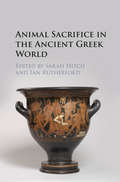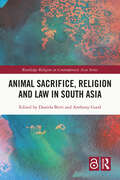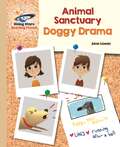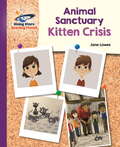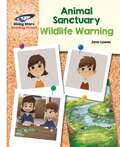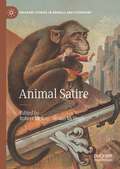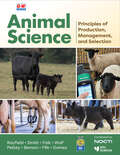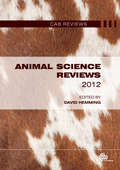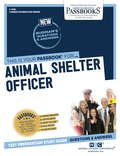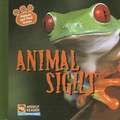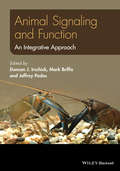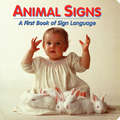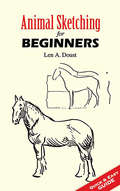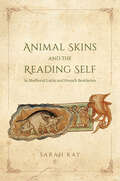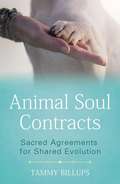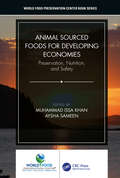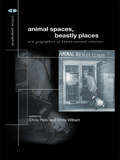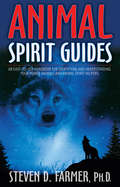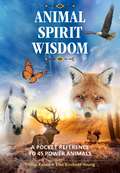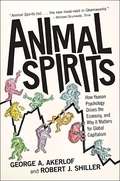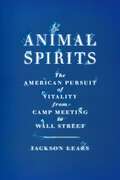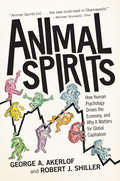- Table View
- List View
Animal Sacrifice in the Ancient Greek World
by Sarah Hitch Ian RutherfordThis volume brings together studies on Greek animal sacrifice by foremost experts in Greek language, literature and material culture. Readers will benefit from the synthesis of new evidence and approaches with a re-evaluation of twentieth-century theories on sacrifice. The chapters range across the whole of antiquity and go beyond the Greek world to consider possible influences in Hittite Anatolia and Egypt, while an introduction to the burgeoning science of osteo-archaeology is provided. The twentieth-century emphasis on sacrifice as part of the Classical Greek polis system is challenged through consideration of various ancient perspectives on sacrifice as distinct from specific political or even Greek contexts. Many previously unexplored topics are covered, particularly the type of animals sacrificed and the spectrum of sacrificial ritual, from libations to lasting memorials of the ritual in art.
Animal Sacrifice, Religion and Law in South Asia (Routledge Religion in Contemporary Asia Series)
by Daniela Berti Anthony GoodThis book presents original research on the controversies surrounding animal sacrifice in South Asia through the lens of court cases. It focuses on the parties involved in these cases: on their discourses, motivations, and contrasting points of view. Through an examination of judicial files, court decisions and newspaper articles, and interviews with protagonists, the book explores how the question of animal sacrifice is dealt with through administrative, legislative, and judicial practice. It outlines how, although animal sacrifice has over the ages been contested by various religious reform movements, the practice has remained widespread at all levels of society, especially in certain regions. It reveals that far from merely being a religious and ritual question, animal sacrifice has become a focus of broader public debate, and it discusses how the controversies highlight the contrast between ‘traditional’ and ‘reformist’ understandings of Hinduism; the conflict between the core legal and moral principles of religious freedom and social progress; and the growing concern with environmental issues and animal rights.
Animal Satire (Palgrave Studies in Animals and Literature)
by Robert McKay Susan McHughAnimal Satire presents a cultural history of animal satire, a critically neglected but persistent presence in the history of cultural production, in which animals expose human folly while the strategies of satire expose the folly of human-animal relations. Highlighting the teeming animal presences across the history of satirical expression from Aristophanes to Twitter, with chapters on key works of literature, drama, film, and a plethora of satirical media, Animal Satire reveals the rich rhetorical significance of animality in powering the politics of satire from ancient and medieval through modern and contemporary times. More pressingly, the book makes the case for the significance of satire for understanding the real-world implications of rhetoric about animals in ongoing struggles for justice. By gathering both critical and creative examples from representative media forms, historical periods, and continents, this volume aims to enrich scholarship on the history of satire as well as empower creative practitioners with ideas about its practical applications today.
Animal Science: Principles Of Production, Management, And Selection
by John S. Rayfield Kasee L. Smith Jeremy Falk Kattlyn Wolf Allen Pettey Drew Parks Benson Jessica Fife Noe Alberto GomezAnimal Science: Principles of Production, Management, and Selection introduces students to the important scientific and applied concepts within the global and domestic animal industries. Serving as an in-depth and hands-on resource for animal science courses, it begins by covering the basics of animal science, including careers, anatomy and physiology, animal health and nutrition, genetics, reproduction, scientific methods, products, and by-products, as well as current issues facing animal scientists. It proceeds with animal-specific sections on beef cattle, swine, sheep, goats, dairy cattle, equine, poultry, and companion animals, each with chapters covering the industry, production, management and care, selection and evaluation, and classification and breeds. Written by an outstanding team of authors who are all current educators with a long history in the animal science industry, this text is up-to-date, well-organized, and extremely image rich with modern, high-quality photos and diagrams. Special features include Before You Read, Did You Know?, Hands-On Animal Science, Safety Notes, Ag Ed Connections, Career Connections, and STEM Connections. It will also serve as a resource and learning tool for programs that don't have a school farm.
Animal Science And Technology class 11 - Maharashtra Board
by Maharashtra State Bureau of Textbook Production and Curriculum ResearchCreated by Maharashtra State Bureau of Textbook Production and Curriculum Research, the text book for class 11 highlights the importance of Indian livestock in the national economy and in the socioeconomic development of the country besides providing food and nutritional security to millions of people. Livestock are the best insurance against the vagaries in nature like draught, famine and other natural calamities. The increasing significance and visible impact of livestock gives stability to agriculture by supplementing family income and generating gainful employment in the rural sector. Thus, livestock provides sustenance to millions of peoples in the vast arid and drought prone area of country. While studying this textbook the section ‘can you recall’ ‘recall a little’ and ‘can you tell’ are used for revision. Many activities given under the titles ‘observe and discuss’ and ‘try this’ ‘use your brain power’ think about it’ etc. will stimulate power of thinking of the students.
Animal Science and Technology class 12 - Maharashtra Board
by Maharashtra State Bureau of Textbook Production and Curriculum ResearchCreated by the Maharashtra State Bureau of Textbook Production and Curriculum Research, livestock sector plays an important role in Indian economy and is an important sub-sector of Indian Agriculture. Growing population, changing lifestyles, expanding urbanization and hastened climatic changes created new challenges to sustain in the situation. Livestock provides stability to family income especially in the arid and semi-arid regions of the country. Animals are the part of our day-to-day life and contribute for stabilizing the agriculture income particularly when monsoon shows its vagaries. The study of their management from scientific views pays us valuable foods viz. milk, meat and eggs, manures and draft power for our agriculture, hides and bones for the country’s economy. Hence, all such concepts of livestock are explained in this book. Further, the diseases of zoonotic importance and their prevention is also incorporated in this textbook from public health point of view to facilitate the learning of the students in a constructive manner.
Animal Science Reviews 2012
by David HemmingAnimal Science Reviews 2012 provides scientists and students with analysis of key topics in current research including breeding, animal behaviour, zoonotic diseases and environment. Experts such as Mike Stear, James France, Phillip Klesius and Frederick Silversides give essential overviews of their fields. Originally published online in CAB Reviews, this volume makes available in printed form the reviews in animal science published during 2012.
Animal Shelter Officer: Passbooks Study Guide (Career Examination Series)
by National Learning CorporationThe Animal Shelter Officer Passbook® prepares you for your test by allowing you to take practice exams in the subjects you need to study. It provides hundreds of questions and answers in the areas that will likely be covered on your upcoming exam, including but not limited to; Care and handling of dogs and other small animals; Clerical aptitude; Understanding and interpreting written material; and more.
Animal Signaling and Function
by Mark Briffa Duncan J. Irschick Jeffrey PodosThe diversity of animal signals has been widely documented, and the generality of animal signals also tantalizingly suggests that there are common mechanisms that have selected for their origin. However, while much progress has been made on some fronts, we still lack a general theory about why the diversity of signaling structures exist. Our compilation will directly address this gap by focusing on an exciting new arena of sexual selection, namely using functional approaches to understand signaling. This approach is rooted in the idea that many signals are designed to transmit important functional imformation that is both important for issues of male quality (and hence male competition), and female choice. The increasing use of technology in sexual selection studies has enabled researchers to test whether signaling is either constrained by, or accurately transmits information about functional capacities. Further, in animals that fight vigorously, functional capacities such as endurance or strength may make the difference between winning and losing. This volume brings together a diverse collection of researchers who are actively investigating how function and signaling are related. These researchers use both a variety of methods and taxa to study animal signaling, and we believe that this integrative view is important to open up fresh vistas for why animal signals have evolved.
Animal Signs: Animal Signs
by Debbie SlierCharming, full-color photographs of basic animals plus illustrations of their corresponding signs offer children ages 1 to 4 a fun way to learn their first signs and vocabulary words. Constructed of sturdy cardboard with a protective finish on each page, this hearty book will withstand the hard use to which fascinated young children will subject it, reading it again and again. Studies have shown that babies who learn to sign can communicate at an earlier age than those who learn verbal communication alone. Other research indicates that children strengthen their grammar and vocabulary skills by learning sign language. Animal Signs and its companion book, Word Signs, offer children exciting new worlds describing favorite things and animals while also making learning language skills fun!
Animal Sketching for Beginners
by Len A. DoustThis handy manual provides the confidence, insight, and guidance to help any sketcher create realistic animal drawings. With the help of the author's thirty-one clearly detailed drawings, this basic how-to-guide:* illustrates major attributes shared by many animals* shows how simple shapes can create complex drawings* functions as a valuable anatomy referenceA source of inspiration for artists at all levels, this book will be especially helpful to beginning art students.
Animal Skins and the Reading Self in Medieval Latin and French Bestiaries
by Sarah KayJust like we do today, people in medieval times struggled with the concept of human exceptionalism and the significance of other creatures. Nowhere is this more apparent than in the medieval bestiary. Sarah Kay’s exploration of French and Latin bestiaries offers fresh insight into how this prominent genre challenged the boundary between its human readers and other animals. Bestiaries present accounts of animals whose fantastic behaviors should be imitated or avoided, depending on the given trait. In a highly original argument, Kay suggests that the association of beasts with books is here both literal and material, as nearly all surviving bestiaries are copied on parchment made of animal skin, which also resembles human skin. Using a rich array of examples, she shows how the content and materiality of bestiaries are linked due to the continual references in the texts to the skins of other animals, as well as the ways in which the pages themselves repeatedly—and at times, it would seem, deliberately—intervene in the reading process. A vital contribution to animal studies and medieval manuscript studies, this book sheds new light on the European bestiary and its profound power to shape readers’ own identities.
Animal Soul Contracts: Sacred Agreements for Shared Evolution
by Tammy BillupsA guide to discovering the spiritual agreements between our souls and those of our animal companions • Explains how animals have physical or behavioral issues to evolve their souls as well as help our soul&’s evolution and release past-life karma • Describes what happens energetically and spiritually with animals in the weeks before they transition and during their passing • Includes practical instructions for identifying the different types of animal soul contracts and aligning with them to assist your shared evolutionary journey Animal lovers are extraordinary. Despite awareness that we will probably outlive our beloved pets, we are still drawn, time and time again, to the connection, joy, and unconditional love that come with sharing our lives, homes, and laps with animals. Many of us feel something deeper than just companionship with our animal friends--a heart-to-heart connection felt all the way to the soul level. Revealing the higher purpose and soul mission behind our relationships with our animal companions, Tammy Billups explores the spiritual contracts that are created when a human bonds with an animal and shows how we come into each other&’s lives for a reason. Providing real-life examples, Billups explains why animals choose, at the soul level, to have certain perceived negative experiences, such as physical or behavioral issues, to evolve their souls, clear karma, and help our soul&’s evolution. She shows that human and animal souls orchestrate every experience and interaction that holds potential for transformation and healing, including the final transition. She demonstrates the inner dynamics of the animal-human relationship to help animal lovers understand their soul contracts with their pets. The inspirational, real-life examples of animal-human tandem healings that Billups facilitated identify the soul contracts within each pairing that transformed feelings of grief, loss, abandonment, betrayal, trauma, abuse, and anxiety. The author reveals how animals we have previously loved and shared our lives with come back, either on the spirit level or reincarnated in a new animal form, to support us. Offering peace and hope to those who&’ve lost beloved animal companions, she describes what she&’s witnessed during healing sessions with animals in the weeks before they transition and during their passing. Billups also includes practical instructions for identifying different types of animal soul contracts and connecting with and enlisting the help of your light team or spirit guides. By discovering the soul agreements that underlie our animal partnerships, we can find meaning in the issues that arise with our animals and ourselves, support our souls&’ mutual evolution, and allow the soul contracts to weave their spiritual magic in the animal-human relationship.
Animal Sourced Foods for Developing Economies: Preservation, Nutrition, and Safety (World Food Preservation Center Book Series)
by Muhammad Issa Khan Aysha SameenAnimal products are good source of disposable income for many small farmers in developing countries. In fact, livestock are often the most important cash crop in many small holder mixed farming systems. Livestock ownership currently supports and sustains the livelihoods of rural poor, who depend partially or fully on livestock for their income and/or subsistence. Human population growth, increasing urbanization and rising incomes are predicted to double the demand for, and production of, livestock products in the developing countries over the next twenty years. The future holds great opportunities for animal production in developing countries. Animal Sourced Foods for Developing Economies addresses five major issues: 1) Food safety and nutritional status in developing world; 2) the contribution of animal origin foods in human health; 3) Production processes of animal foods along with their preservation strategies; 4) functional outcomes of animal derived foods; and finally, 5) strategies, issues and polices to promote animal origin food consumption. Animal sourced food contain high biological value protein and important micronutrients required for optimal body functioning but are regarded as sources of fat that contribute to the intake of total and saturated fatty acids in diet. The quality of protein source has a direct influence on protein digestibility, as a greater proportion of higher quality proteins is absorbed and becomes available for bodily functions. Animal foods has high quantity and quality of protein that includes a full complement of the essential amino acids in the right proportion. Land availability limits the expansion of livestock numbers in extensive production systems in most regions, and the bulk of the increase in livestock production will come from increased productivity through intensification and a wider adoption of existing and new production and marketing technologies. The significant changes in the global consumption and demand for animal source foods, along with increasing pressures on resources, are having some important implications for the principal production systems. In this book, contributors critically analyze and describe different aspects of animal’s origin foods. Each chapter is dedicated to a specific type of food from animal source, its nutritional significance, preservation techniques, processed products, safety and quality aspects on conceptual framework. Special attention is given to explain current food safety scenario in developing countries and contribution of animal derived food in their dietary intake. Existing challenges regarding production, processing and promotion of animal’s origin foods are also addressed with possible solutions and strengthening approaches.
Animal Spaces, Beastly Places (Critical Geographies)
by Chris Philo Chris WilbertAnimal Spaces, Beastly Places examines how animals interact and relate with people in different ways. Using a comprehensive range of examples, which include feral cats and wild wolves, to domestic animals and intensively farmed cattle, the contributors explore the complex relations in which humans and non-human animals are mixed together. Our emotions involving animals range from those of love and compassion to untold cruelty, force, violence and power. As humans we have placed different animals into different categories, according to some notion of species, usefulness, domesticity or wildness. As a result of these varying and often contested orderings, animals are assigned to particular places and spaces. Animal Spaces, Beastly Places shows us that there are many exceptions and variations on the spatiality of human-animal spatial orderings, within and across cultures, and over time. It develops new ways of thinking about human animal interactions and encourages us to find better ways for humans and animals to live together.
Animal Spirit Guides: An Easy-to-use Handbook For Identifying And Understanding Your Power Animals And Animal Spirit Helpers
by Steven D. FarmerAfter the publication of his best-selling book Power Animals, many people inquired about the meaning of spirit animals that were not contained in that work. In Animal Spirit Guides, Dr. Farmer provides concise, relevant details about the significance of more than 200 animals that may come to you in physical or symbolic form as guides and teachers. With each animal listed, you’ll find general meanings of the visitation; practical ways that they can help you as spirit guides; and how, as your power animal, they reflect characteristics that you possess. You’ll also find a "whom-to-call-on" section that will tell you which animal spirit guide to call on for any specific purpose.
Animal Spirit Wisdom: A Pocket Reference to 45 Power Animals
by Phillip Kansa Elke Kirchner-Young• Explores 45 different power animals alphabetically and shares their strengths, wisdom, special energies, and how to connect with them • Provides a meditative journey to help you discover which animal is your personal soul companion • Offers practices--such as observing your dreams, carving or drawing your animal guide, or opening the book to a random page--to intuitively find the right power animal for a given situation or for support and protection in a difficult period Since the beginning of time, animals have played an important role in each of our lives. Early humans were almost entirely dependent on the animal kingdom for survival. Shamans both ancient and modern merged in trance with their animal allies for spiritual guidance. Native Americans learned their personal totem animal in childhood and viewed them as life-long companions. And today we can still call on our power animals for strength, serenity, inspiration, and support. In this full-color pocket guide featuring beautiful animal photos, the authors introduce 45 important spirit animals alphabetically and explore their wisdom, special energies, and how to connect with them. They provide a meditative journey to help you discover which animal is your personal soul companion and offer practices--such as observing your dreams, carving or drawing your animal guide, or opening the book to a random page--to intuitively find the right power animal for a given situation or for support and protection in a difficult period. Is your spirit animal an eagle, deer, or wolf, or will you be surprised to find connections to a hummingbird, dolphin, or fire salamander? With this reference, you can call on the healing power of the bear to strengthen your body and keep calm, the far-reaching and precise vision of the hawk to see imbalances in your life, or the intelligence of the owl to make wise decisions. This book offers an accessible starting point for your journey of discovery through the diverse kingdom of spirit animals.
Animal Spirits: How Human Psychology Drives the Economy, and Why It Matters for Global Capitalism
by George A. Akerlof Robert J. ShillerThe global financial crisis has made it painfully clear that powerful psychological forces are imperiling the wealth of nations today. From blind faith in ever-rising housing prices to plummeting confidence in capital markets, "animal spirits" are driving financial events worldwide. In this book, acclaimed economists George Akerlof and Robert Shiller challenge the economic wisdom that got us into this mess, and put forward a bold new vision that will transform economics and restore prosperity. Akerlof and Shiller reassert the necessity of an active government role in economic policymaking by recovering the idea of animal spirits, a term John Maynard Keynes used to describe the gloom and despondence that led to the Great Depression and the changing psychology that accompanied recovery. Like Keynes, Akerlof and Shiller know that managing these animal spirits requires the steady hand of government--simply allowing markets to work won't do it. In rebuilding the case for a more robust, behaviorally informed Keynesianism, they detail the most pervasive effects of animal spirits in contemporary economic life--such as confidence, fear, bad faith, corruption, a concern for fairness, and the stories we tell ourselves about our economic fortunes--and show how Reaganomics, Thatcherism, and the rational expectations revolution failed to account for them. Animal Spirits offers a road map for reversing the financial misfortunes besetting us today. Read it and learn how leaders can channel animal spirits--the powerful forces of human psychology that are afoot in the world economy today. In a new preface, they describe why our economic troubles may linger for some time--unless we are prepared to take further, decisive action.
Animal Spirits: The American Pursuit of Vitality from Camp Meeting to Wall Street
by Jackson Lears"[A] master class in American cultural and intellectual history." —Sarah E. Igo, The New York Times Book Review"Jackson Lears is the preeminent cultural historian of the American empire. This book is another masterpiece in his magisterial corpus.’’ —Cornel WestA master historian's retrieval of the spiritual visions and vitalisms that animate American life and the possibilities they offer today.In Animal Spirits, the distinguished historian Jackson Lears explores an alternative American cultural history by tracking the thinkers who championed the individual’s spontaneous energies and the idea of a living universe against the strictures of conventional religion, business, and politics. From Puritan times to today, Lears traces ideas and fads such as hypnosis and faith healing from the pulpit and stock exchange to the streets and the betting table. We meet the great prophets of American vitality, from Walt Whitman and William James to Andrew Jackson Davis (the “Poughkeepsie Seer”) and the “New Thought” pioneer Helen Wilmans, who spoke of the “god within—rendering us diseaseless incarnations of the great I Am."Well before John Maynard Keynes stressed the reliance of capitalism on investors’ “animal spirits,” these vernacular vitalists established an American religion of embodied mind that also suited the needs of the marketplace. In the twentieth century, the vitalist impulse would be enlisted in projects of violent and racially charged national regeneration by Theodore Roosevelt and his legatees, even as African American writers confronted the paradoxes of primitivism and the 1960s counterculture imagined new ways of inspiriting the universe. Today, scientists are rediscovering the best features of the vitalist tradition—permitting us to reclaim the role of chance and spontaneity in the conduct of our lives and our understanding of the cosmos.Includes 8 pages of black-and-white images
Animal Spirits: How Human Psychology Drives the Economy, and Why It Matters for Global Capitalism
by Robert J. Shiller George A. AkerlofThe global financial crisis has made it painfully clear that powerful psychological forces are imperiling the wealth of nations today. From blind faith in ever-rising housing prices to plummeting confidence in capital markets, "animal spirits" are driving financial events worldwide. In this book, acclaimed economists George Akerlof and Robert Shiller challenge the economic wisdom that got us into this mess, and put forward a bold new vision that will transform economics and restore prosperity. Akerlof and Shiller reassert the necessity of an active government role in economic policymaking by recovering the idea of animal spirits, a term John Maynard Keynes used to describe the gloom and despondence that led to the Great Depression and the changing psychology that accompanied recovery. Like Keynes, Akerlof and Shiller know that managing these animal spirits requires the steady hand of government--simply allowing markets to work won't do it. In rebuilding the case for a more robust, behaviorally informed Keynesianism, they detail the most pervasive effects of animal spirits in contemporary economic life--such as confidence, fear, bad faith, corruption, a concern for fairness, and the stories we tell ourselves about our economic fortunes--and show how Reaganomics, Thatcherism, and the rational expectations revolution failed to account for them. Animal Spirits offers a road map for reversing the financial misfortunes besetting us today. Read it and learn how leaders can channel animal spirits--the powerful forces of human psychology that are afoot in the world economy today. In a new preface, they describe why our economic troubles may linger for some time--unless we are prepared to take further, decisive action.
